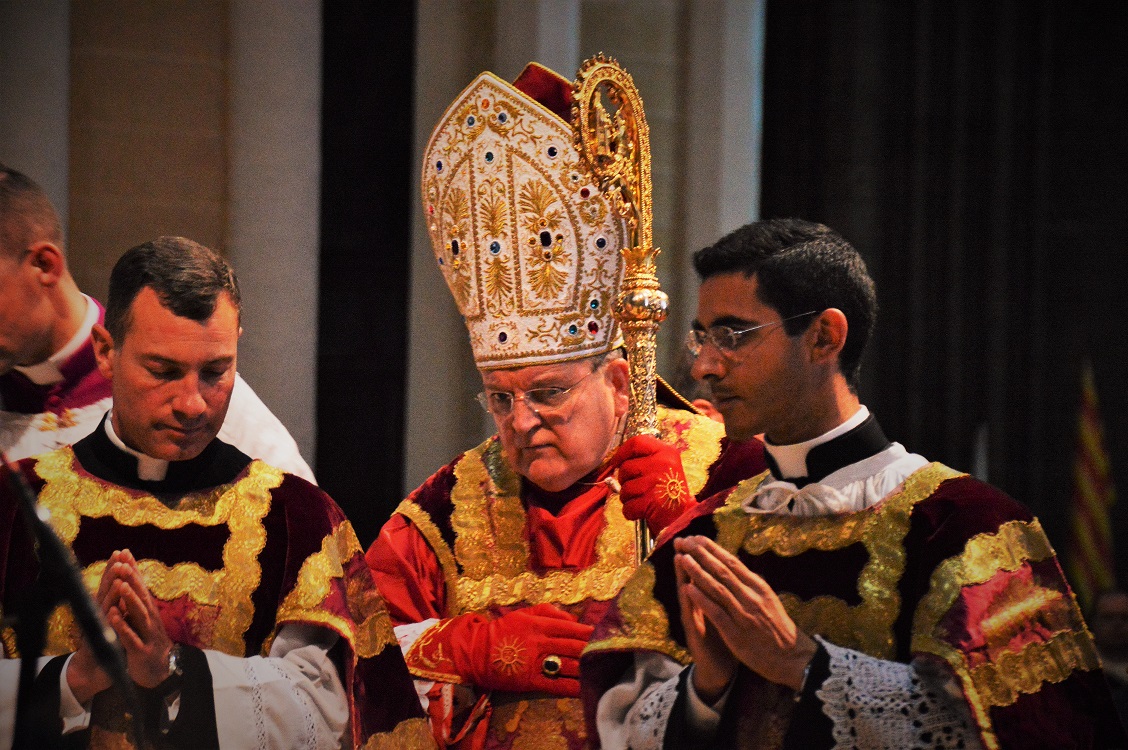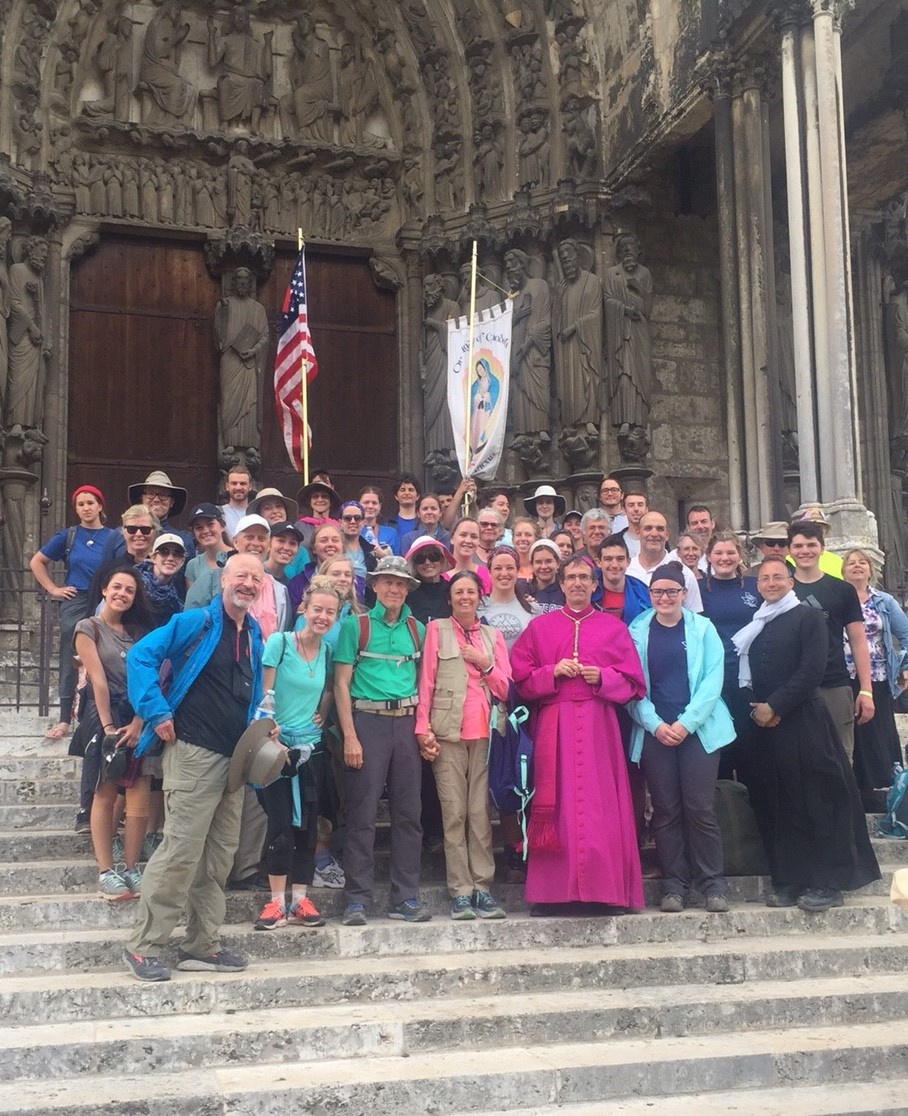I wonder if any of those first Chartres pilgrims ever imagined that some day high-ranking prelates would celebrate Solemn Pontifical High Masses not only in Chartres at the conclusion of the Pilgrimage, but also at Notre-Dame de Paris at its beginning.
I wonder if they ever could have anticipated that prominent political figures, such as Marion Jeanne Marechal-Le Pen—niece of Marine La Pen, Front National candidate who came in second in this year’s race for the presidency of France—would one day be walking among the pilgrims to Chartres every year.
Standing there locked out of their own Cathedral 35 years ago, could they have imagined pilgrims from all over the world would travel thousands of miles to join the pilgrims on the road to Chartres.
Because of their humble efforts, the Pilgrimage to Chartres would one day blossom into an international event, more than any other, provides living, breathing proof of the youth and vitality of a growing Catholic restoration movement.
The pilgrims to Chartres stand on the shoulders of giants, in other words—men who refused to abandon the Faith of our Fathers.
 Cardinal Burke (Chartres Pilgrimage 2017)
Cardinal Burke (Chartres Pilgrimage 2017)Just ahead of the Cardinal was the reliquary containing the glory of Chartres—the Veil of Our Lady, Christendom’s most holy relic, and the reason the Cathedral was built. The Veil was elevated on the shoulders of several scouts, and, some with tears of joy in their eyes, the pilgrims knelt in veneration as it passed. This is the silk garment which Our Lady used to cover the Baby Jesus in Bethlehem’s cave. It was discovered, along with the true Cross, by St. Helena, and was later given to Charlemagne by the Byzantine Empress Irene. Its history is rich and meticulously chronicled, since Charlemagne’s grandson, Charles the Bald, donated the veil to Chartres in the ninth century. Recent carbon 14 analysis of the veil reveal evidence of first century pollen from Palestine in its weave.
It was to venerate this holy veil that the pilgrims of the Middle Ages came; and for the same reason they come today--that and to proclaim the kingship of Christ. And while this holy veil caused Christendom’s gothic jewel in Chartres to become the fourth most popular place of pilgrimage in Christendom, for a time in the last part of the nineteenth century the popularity of the Chartres Pilgrimage began to wane. Its rejuvenation was sparked in the early part of the 20th century when a then-agnostic poet named Charles Péguy took it upon himself to walk from Paris to Chartres in search of the intercession of the Mother of God.
His story is well worth the retelling, as it offers yet another powerful testimonial to the efficacy of Our Lady’s intercession, especially when prayed for at the place Henry Adams describes as “Our Lady’s Playhouse”.
Charles Péguy

For a good part of his life, Charles Péguy (1873 – 1914), was an ardent socialist and an on-again, off-again agnostic. Before his death on the battlefield in the early days of World War I, he’d become a believer whose gradual conversion was met with disbelief by France’s literary community.
For Péguy, his coming to terms with the Catholic Faith was a lonely and often turbulent fight that manifested itself through some of the most soul-stirring and provocative French-language poetry of the 20th century.
Though he’d become a believer, it wasn’t until Péguy found himself on the battlefield that he resolved to fully return to the Sacraments. Nevertheless, so compelling was his written record of transformation from agnostic to believer that when word of his death reached T. S. Eliot the great English-language poet mourned “one of the most illustrious of the dead who have fallen in this war.”
Péguy is no plaster saint. His journey into the light is not without long and extended dark nights. Even after his conversion he remained among the walking wounded of post-Revolution “enlightened” France, ever searching for a way back home. As one writer put it, “Péguy seems to have come to an understanding through his experience that pain and even a vulnerability to sinfulness often are the only ways to open channels by which real grace can reach us, particularly those of us who think our faith and morals are already enough.”
Not surprisingly, the notion of Catholic pilgrimage emerges as integral to the struggle of Charles Péguy, so much so, in fact, that this passionate and often volatile personality practically single handedly breathed life back into what had come to be regarded as an outmoded “medieval ritual”.
Had it not been for Péguy it is highly unlikely that the Chartres Pilgrimage would have survived the attempted purging of all things Catholic which took place in Europe from World War I to the present.
Here is what happened.
Charles Péguy’s son Marcel had fallen deathly ill and, rather than giving in to despair, Péguy placed his son in the hands of the Blessed Virgin Mary – vowing to retrace the ancient pilgrim’s path (the French starting point on the Pilgrimage to Santiago de Compostela) from Paris to Chartres when his son regained his health.
Marcel recovered, and his father was true to his word, walking to Chartres not once but several times before his death two years later. Through the process of physical pilgrimage the warrior poet evidently sought to earn the right to lay claim to the Faith he’d once strained against. Pious platitudes and easy creeds were not the stuff of which Charles Péguy was made. He was a soldier and a poet, but not a saint and, as such, the notion of pilgrimage appealed to his warrior heart.
Inspired by his example if baffled by his conversion, friends tracked Péguy along his newfound pilgrim’s path. And after his death, when his popularity began to increase, admirers from all walks became interested in retracing the footsteps not only of Joan of Arc and St. Louis IX, but also Charles Péguy—over the plain la Beauce, through the forests near Choisel, and into the gothic sanctuary of Notre-Dame de Chartres where Péguy had surrendered his cold rationalism at the altar of Faith. Here the sophisticated man of letters shocked the world by humbly declaring himself “subject to the Virgin of Chartres.” And all Paris gasped!
In the Footsteps of Péguy
Twenty-six years ago, The Remnant began organizing the U.S. contingent on the Pilgrimage. In May of 2017, over one hundred Americans again crossed the Atlantic seeking to find what Péguy had found. Like him, they sought to place themselves in the hands of the Mother of God.
Like Péguy’s Marcel, their children are also dying, in the sense that their souls are under constant assault from those who would sooner see them dead than Catholic.
Like Péguy’s, their world is also on the brink of war, perhaps literally, but certainly morally and spiritually.
Like Péguy, the pilgrims are not saints, which is why during this worldwide offensive against marriage and the family, the unborn, the innocence of children and the Church herself—they recognize no better means of surviving the onslaught than falling to their knees before the Mother of God.
The sight of the Cathedral—after walking three days, sleeping on the ground for two nights, eating the meager pilgrim’s fare—offers promise of home. Along the road to Chartres, it’s as if the revolution in the Church never happened.
A Shepherd in the Camp
At the end of the second day, as the American chapter made its way down the steep embankment into the camp, we were surprised to find Cardinal Raymond Burke, greeting each chapter as the miles-long column of pilgrims entered the camp.
After being subject to so much derision for his strong defense of marriage and the family, here in camp the Cardinal was hailed as a hero, as a thousand pilgrims knelt to kiss his ring. He seemed filled with joy, as if here he’d found the Church Militant as it should be— fully and unapologetically Catholic!
It was a beautiful moment, as Cardinal and Pilgrim seem to be reassuring each other that all is not lost and that, together, we will keep the faith.

The Pilgrimage came to an end in Notre-Dame de Chartres on Pentecost Monday. Eight thousand pilgrims packed the cathedral, and another seven thousand filled the square outside. In one voice the massive assembly brought their pilgrimage to a glorious conclusion with the Chez Nous—the love song to Our Lady. And now it’s back to the front—the blisters, rocky ground, damp sleeping bags, meager soup, hard bread and endless walking having once again become the happy memories of the grand Catholic adventure that is the Pilgrimage to Chartres.
The years move along. They young French scouts who dominate the pilgrimage, were not yet born when I made my first walk to Chartres. To them I suppose, if they think of me at all, I’m the old pilgrim from America who walked to Chartres with their mothers and fathers many years ago. But I wonder if they realize how much they mean to me—how much hope the sight of them singing or praying or playing stirs in this old American’s heart. Where did they come from? How did they survive…these beautiful Catholics with their smart-looking blue uniforms, big boots and broad, easy smiles? How is it that they were spared the all-out assault on innocence that is the purview of the modern world?
The answer is obvious: Throughout their new, little lives they’ve been walking to Chartres every Pentecost weekend. They go there to find their Mother, to sing for her and to blithely place themselves under her protection. Chartres is her playhouse, and these are the children with whom she plays—the children she makes her own. They belong to her, safe and protected beneath her veil.
Maybe that’s why we all go back Chartres each year—to be with her, to become Mary’s children again, who trust and hope in her so intuitively and so completely that she can’t refuse to make us her own. At Chartres, Mary makes us hers again, and on this side of heaven’s gate there is no greater feeling than that.
Chez nous soyez Reine, nous sommes a vous. Regnez en souveraine, Chez nous, chez nous.
 Record Numbers Walk from Paris to Chartres
Record Numbers Walk from Paris to Chartres

